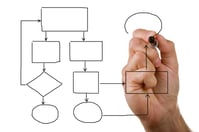Share this
Using business rules to create a better software development lifecycle
by Craig McLean on 07 January 2011
I recently finished Ron Ross' book 'Business Rule Concepts - Getting to the Point of Knowledge' in which he emphasises that true business process agility is achieved by de-coupling business rules from the processes and events which they govern.
"You get thin processes by externalising business rules ..."
I've already had an opportunity to apply this and have seen how separating rules - as well as channels - from processes, leaves you with much fewer and simpler process patterns. Over eighty procedures were simplified to a dozen "essential" processes.

The question which most interests me, however, is how does this apply to the business process we often refer to as the Software Development Lifecycle.
What do the business rules which guide this process relate to?
- Completeness (or state) of artifacts?
- Traceability between artifacts?
- Level of understanding?
- Degree of risk?
What are the events (flash points) at which these rules are tested?
- Approval?
- Product handover?
- Creation or adjustment of artifacts (requirements, design concepts, code, tests)?
Are the various rules (often refrerred to as business knowledge) actually what differentiates one method from another? So some rules drive a specific approach (e.g. All design concepts must be specified before coding begins would drive a waterfall approach).
This is a rule which drives behaviour. Other rules provide definitions (e.g. a user story consists of ...) and these may also differentiate one method from another.
But some rules seem to be more methodology agnostic in nature (e.g. a piece of code must help to implement a specified requirement).
So if we strip out all the software development rules, particularly the methodology-related sequencing (governance) and artifact definition rules, what are we left with?
A process which says we do analysis, design, build and test in a sequence determined by the business rules? Will this be just the activities which make up the essence of software development? If we add the methodology agnostic rules (the best practice rules) how much does this change our essential SDLC?
Do we then replace any methodology specific rules (behavioural and definitional) with a set of generic rules which are based on the facts of the project in question? That is, degree of risk, expected cost, type of development, business domain etc.
If we documented this SDLC it should be much simpler and more static than previous methodologies. We wouldn't attempt to specify the possible alternate paths through this process (as previous methodologies, PRISM etc., have done) as the permutations would be almost infinite.The possible variations in approach would not fall within any of waterfall, formal iterative or agile styles but could fit anywhere on a continuum from rigid discipline related phases to short time-boxed iterations.

The end result would be a dynamic and truly agile software development process, possibly the last SDLC we'd ever need.
Share this
- Agile Development (84)
- Software Development (64)
- Scrum (39)
- Business Analysis (28)
- Agile (27)
- Application Lifecycle Management (26)
- Capability Development (20)
- Requirements (20)
- Solution Architecture (19)
- Lean Software Development (17)
- Digital Disruption (16)
- IT Project (15)
- Project Management (15)
- Coaching (14)
- DevOps (14)
- Equinox IT News (12)
- IT Professional (11)
- Knowledge Sharing (10)
- Strategic Planning (10)
- Agile Transformation (9)
- Digital Transformation (9)
- IT Governance (9)
- International Leaders (9)
- People (9)
- IT Consulting (8)
- AI (7)
- Cloud (7)
- MIT Sloan CISR (7)
- ✨ (7)
- Change Management (6)
- Azure DevOps (5)
- Innovation (5)
- Working from Home (5)
- Business Architecture (4)
- Continuous Integration (4)
- Enterprise Analysis (4)
- FinOps (4)
- Client Briefing Events (3)
- Cloud Value Optimisation (3)
- GitHub (3)
- IT Services (3)
- Business Rules (2)
- Data Visualisation (2)
- Java Development (2)
- Security (2)
- System Performance (2)
- Automation (1)
- Communities of Practice (1)
- Kanban (1)
- Lean Startup (1)
- Microsoft Azure (1)
- Satir Change Model (1)
- Testing (1)
- November 2025 (1)
- August 2025 (3)
- July 2025 (3)
- March 2025 (1)
- December 2024 (1)
- August 2024 (1)
- February 2024 (3)
- January 2024 (1)
- September 2023 (2)
- July 2023 (3)
- August 2022 (4)
- July 2021 (1)
- March 2021 (1)
- February 2021 (1)
- November 2020 (2)
- July 2020 (1)
- June 2020 (2)
- May 2020 (2)
- March 2020 (3)
- August 2019 (1)
- July 2019 (2)
- June 2019 (1)
- April 2019 (2)
- October 2018 (1)
- August 2018 (1)
- July 2018 (1)
- April 2018 (2)
- January 2018 (1)
- September 2017 (1)
- July 2017 (1)
- February 2017 (1)
- January 2017 (1)
- October 2016 (2)
- September 2016 (1)
- August 2016 (4)
- July 2016 (3)
- June 2016 (3)
- May 2016 (4)
- April 2016 (5)
- March 2016 (1)
- February 2016 (1)
- January 2016 (1)
- December 2015 (5)
- November 2015 (11)
- October 2015 (3)
- September 2015 (1)
- August 2015 (1)
- July 2015 (7)
- June 2015 (7)
- April 2015 (1)
- March 2015 (2)
- February 2015 (2)
- December 2014 (3)
- September 2014 (2)
- July 2014 (1)
- June 2014 (2)
- May 2014 (8)
- April 2014 (1)
- March 2014 (2)
- February 2014 (2)
- November 2013 (1)
- October 2013 (2)
- September 2013 (2)
- August 2013 (2)
- May 2013 (1)
- April 2013 (3)
- March 2013 (2)
- February 2013 (1)
- January 2013 (1)
- November 2012 (1)
- October 2012 (1)
- September 2012 (1)
- July 2012 (2)
- June 2012 (1)
- May 2012 (1)
- November 2011 (2)
- August 2011 (2)
- July 2011 (3)
- June 2011 (4)
- April 2011 (2)
- February 2011 (1)
- January 2011 (2)
- December 2010 (1)
- November 2010 (1)
- October 2010 (1)
- February 2010 (1)
- July 2009 (1)
- October 2008 (1)